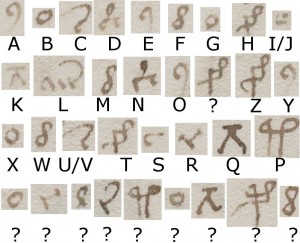A Quality Assurance auditor from Cross Plains, Wisconsin, Mark Sullivan has been thinking about the VMs since the 1970s… and now suspects he has possibly glimpsed at least part of the answer, putting his current notes on a newly-started blog.
The key to it all, he believes, lies in the vertical column of Voynichese letters down the left-hand edge of page f66r: he thinks that the “9” character falls where vowels lie in the Latin alphabet, though when that pattern breaks down (at “O”), his idea is that the plaintext alphabet is somehow reversed (i.e. Z, Y, X, etc), which I take to mean something broadly along the following lines:-

Voynich Manuscript f66r, vertical column rearranged
Furthermore, he believes that paragraph-initial gallows “reflect forms of hic and qui“; that there is “an underlying system” involving “three columns with multiple sequences of equivalent letter groups“; and that there is also a kind of (verbose) number system at play.
Is this any good? To me, it hinges on what you make of the f66r vertical column. Though A, E and O do indeed match up nicely to the three “9” (EVA <y>) characters in the list, and “K” is apparently mapped to a rotated K glyph, the rest is fairly wobbly: F, M and W all map to the same “8” (EVA <d>) glyph, as do D and N (to the EVA <sh> pair), and the B and X (EVA <o>). Yet once you start introducing a degree of interpretation into a Latin-like text, you almost inevitably end up with something not too dissimilar to Brumbaugh’s ARABYCCUS and PAPERYCUS – fragmentary motes of Latin, evanescently bubbling to the surface in a sea of syllables.
These days, I don’t really have any belief that someone is going to waltz in from the wings holding aloft anything resembling a monoalphabetic substitution key to the VMs: and as a possible source for such a key, the vertical column on f66r doesn’t really do it for me. Moreover, I don’t think “K” appeared in the Latin alphabet as used by Quattrocento cipher makers, which would rather throw this sequence out. But perhaps I’ve got all that wrong, and should instead heed the wisdom of sagacious songwriter George Michael, who back in 1987 sang “I gotta have faith-a-faith-a-faith“. Oh, well!
According to the “codebook cipher” theory, the Voynich manuscript “words” would actually be codes to be looked up in a “dictionary” or codebook. The main evidence for this theory is that the internal structure and length distribution of many words are similar to those of Roman numerals, which at the time would be a natural choice for the codes. However, book-based ciphers would be viable for only short messages, because they are very cumbersome to write and to read.